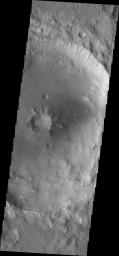
|
Crater Centers
- Click the image above for a larger view
- Full-Res JPEG (1298 x 2801) (296.5 kB)
- Full-Res TIFF (1298 x 2801) (3.6 MB)
Caption:
Impact craters can have a variety of floor features. Depending on the size of the meteorite and the material it is hitting the resultant crater can have a flat floor, a central peak or a central peak with a pit in it. The peak and peak/pit combination are formed by rebound of the surface material that has been melted and pulverized. Today's image is a central peak/pit combination crater in Terra Cimmeria.
Orbit Number: 40978 Latitude: -38.0765 Longitude: 171.308 Instrument: VIS Captured: 2011-03-11 09:43
Background Info:
Please see the THEMIS Data Citation Note for details on crediting THEMIS images.
NASA's Jet Propulsion Laboratory manages the 2001 Mars Odyssey mission for NASA's Science Mission Directorate, Washington, D.C. The Thermal Emission Imaging System (THEMIS) was developed by Arizona State University, Tempe, in collaboration with Raytheon Santa Barbara Remote Sensing. The THEMIS investigation is led by Dr. Philip Christensen at Arizona State University. Lockheed Martin Astronautics, Denver, is the prime contractor for the Odyssey project, and developed and built the orbiter. Mission operations are conducted jointly from Lockheed Martin and from JPL, a division of the California Institute of Technology in Pasadena.
Cataloging Keywords:
| Name | Value | Additional Values |
|---|---|---|
| Target | Mars | |
| System | ||
| Target Type | Planet | |
| Mission | 2001 Mars Odyssey | |
| Instrument Host | Mars Odyssey | |
| Host Type | Orbiter | |
| Instrument | Thermal Emission Imaging System (THEMIS) | |
| Detector | ||
| Extra Keywords | Crater, Grayscale, Impact, Thermal | |
| Acquisition Date | ||
| Release Date | 2011-04-12 | |
| Date in Caption | 2011-03-11 | |
| Image Credit | NASA/JPL/ASU | |
| Source | photojournal.jpl.nasa.gov/catalog/PIA14034 | |
| Identifier | PIA14034 | |

